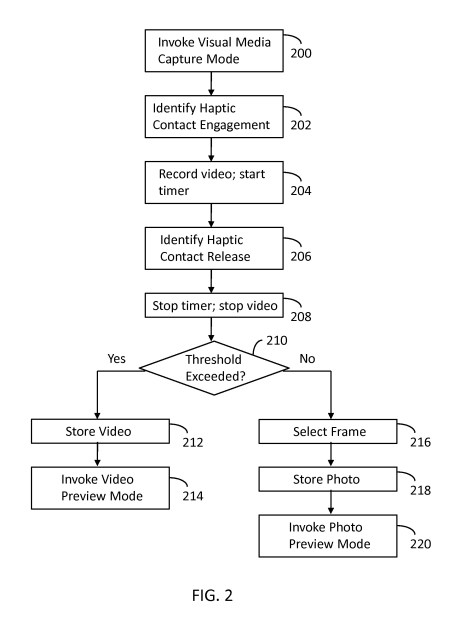While larger competitors struggle to differentiate themselves with different video lengths, Snapchat could use a different weapon to be the first camera app opened: speed. And unlike filters, this one will be more difficult to copy.
Snapchat has a patent, “Single mode visual media capture,” on its technology that allows the user to take a picture by tapping the camera button and a video by holding down the same camera button. Photos are simply taken by the tap, and videos end when you release the camera button, or after 10 seconds.
The app always opens directly to the camera screen, and this single camera, single button for both photo and video makes capturing moments simple and very fast. Vine’s recording interface is most similar, and is also quite quick, but it only does video.
By comparison, to move from photo to video in Instagram, you have to hit the video button, wait for the camera to shutter for a few seconds, move to a new screen, then press and hold to record. In Poke, Facebook’s Snapchat clone, you have to select camera or video camera before you see the capture screen; and, again, there’s loading time for the camera to open before you can capture something. Even in the standard iPhone camera app, you have to slide the dial from camera to video, wait for the camera to shutter for a couple seconds, then shoot.

Figure 2 of the patent shows the processing operations behind Snapchat’s photo and video taking apparatus.
This might seem like a trivial difference, but waste a couple seconds to switch to video or to wait for your camera app to load and the moment you were hoping to capture could be over.
The patent could also help Snapchat settle a pesky lawsuit. Frank Reginald “Reggie” Brown is currently suing Snapchat and co-founders Evan Spiegel and Bobby Murphy; Brown claims he was a co-founder of the company and was forced out by Spiegel and Murphy.
In a lawsuit filed in February 2013, Brown alleges:
“In addition, at this time [summer of 2011], Brown undertook the responsibility of drafting and filing a patent application for the technology used in the Application, which named Brown and the Individual Defendants as co-investors. Brown prepared the patent application and filed it with the United States Patent Office on behalf of the joint venture/partnership.”
As I wrote in March, this original patent led to a major argument:
“There was a big argument over patent filing,” the first source tells me. “Then there was a huge fight where each person said terrible things about the other and then Spiegel changed the passwords and Reggie just sat and waited to file…it was something to do with who’s name was listed first. Literally a pointless argument. The bigger thing was what happened after. I really don’t think the patent ended up being a problem. It’s pretty much just a fight between friends and people calling each other out. Not much basis for why they actually had a big split up.”
Nearly a year later, in August 2012, Spiegel and Murphy filed this patent.
Until recently, patent searches for Brown, Spiegel, Murphy, Snapchat, and even the company’s early names like Picaboo and Toyopa Group, came up with nothing.
A representative from the United States Patent Office tells me an “inventor can ask for an application not to be published at all until the patent is actually issued.” The patent eventually gets abandoned if it is never issued. The representative noted that if an application has multiple inventors, any of them can file a non-publication request.
A lawyer from the firm Lee, Tran & Liang, Brown’s representatives, confirmed the statement in the February 2013 complaint, but could not comment further due to the nature of the ongoing case.
